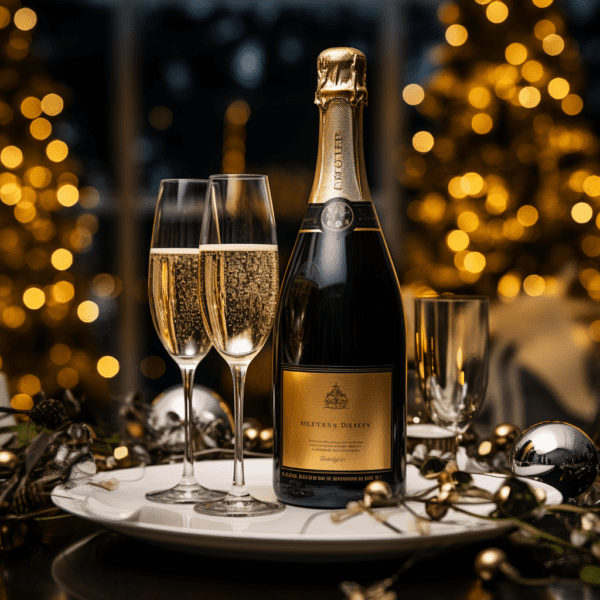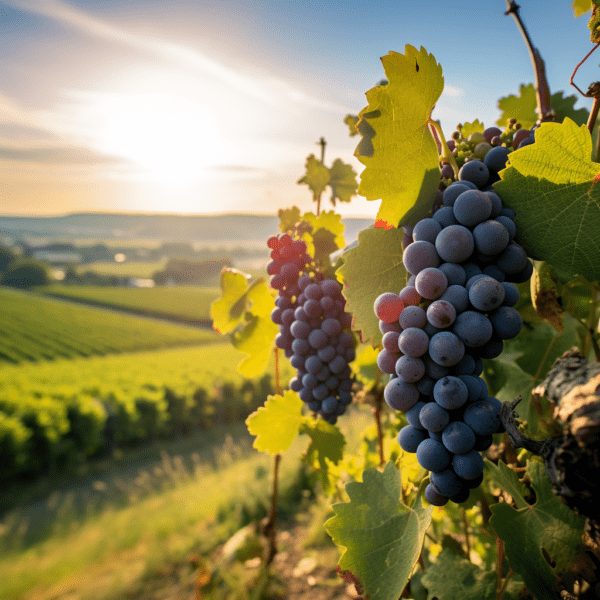
Welcome to the world of Champagne, where elegance and effervescence meet in a glass.
In this article, we’ll delve into the captivating realm of Champagne, demystifying its origins, production, and unique qualities.
You’ll discover why this sparkling wine is revered worldwide and how it sets itself apart from other bubbly beverages.
What is Champagne?
Champagne, the epitome of sparkling sophistication, is not just a wine; it’s a legacy that bears the name of its illustrious region.
To bear the coveted name on its label, a Champagne must adhere to a meticulously regulated set of standards.
These regulations govern every facet of its creation, from the grape varieties used to the winemaking method employed.

How Champagne is Made
When it comes to crafting Champagne, one method reigns supreme: the Méthode Champenoise.
This traditional approach distinguishes Champagne from other sparkling wines.
Here’s the secret: after the initial fermentation to create a dry base wine, a special mixture of yeast and sugar, known as the “liqueur de tirage,” is added.
This mixture sparks the second fermentation inside the bottle, a process that creates the mesmerizing bubbles.

Categories of Champagne Producers
Champagne production is a world of diverse artisans.
We categorize Champagne producers into two distinct groups: Récoltant-Manipulant and Négociant-Manipulant.
Récoltant-Manipulant
These independent artisans craft their wines on-site, using grapes solely from their vineyards.
They are the creators of “grower Champagnes,” a rare gem in the international market.
Négociant-Manipulant
On the flip side, there are the well-known “big brands,” such as Veuve Clicquot and Moët Chandon.
They purchase grapes, grape must, or wine to create Champagne under their labels.
Grape Varieties in Champagne
Three main grape varieties reign supreme in Champagne: Pinot Noir, Chardonnay, and Pinot Meunier.
These grapes form the heart and soul of Champagne each contribute distinct characteristics to the final product.

Additionally, Champagne’s organic farmers aim to capture the essence of the soil in their grapes.
The flavor profiles depend not only on the grape variety but also on the unique terroir elements, including soil composition, subsoil, gradient, and more.
Terroir and Climate in Champagne
The Champagne region’s unique terroir and climate play pivotal roles in shaping the character of this exquisite wine.
Beneath the topsoil lies a subsoil predominantly composed of limestone, with sedimentary rock outcrops varying by vineyard location.
Moreover, the dual oceanic-continental climate and steep slopes ensure ample sun exposure, which further contributes to Champagne’s exceptional qualities.
Every vineyard plot has a distinct profile, courtesy of the terroir’s varying environments.

Taste Profile of Champagne
When it comes to taste and flavor, Champagne is a symphony of sensory delights.
Champagne often entices with a bouquet that includes hints of warm toast, the earthiness of raw almonds, and the zestiness of lemon peel.
These aromatic notes set the stage for what’s to come in each sip.
As you take that first delightful sip, you’ll encounter a harmonious blend of bright citrus and crisp apple flavors.
These vibrant notes dance gracefully with toasty and nutty undertones, creating a refreshing and complex tasting experience.
It’s not uncommon to detect a subtle creaminess in both flavor and texture, adding a touch of luxury to the palate.
One of Champagne’s defining characteristics is its elevated acidity, which brings a zesty liveliness to every sip.
This acidity is perfectly balanced by the wine’s light body and the delicate dance of bubbles that tickle the senses.
Most Champagnes are white wines, resulting in a low tannin content that allows the wine’s other qualities to shine through.

The sweetness levels in Champagne
The amount of sugar, known as dosage, added during the secondary fermentation determines the wine’s sweetness.
Here’s a breakdown of the terminologies you’ll find on the label and what they signify.
Brut Nature
This Champagne is bone dry, with little to no added sugar, often containing up to three grams of sugar per liter.
Extra Brut
Slightly sweeter than Brut Nature, this wine may have up to six grams of sugar per liter but still retains a dry profile.
Brut
Considered fairly dry, Brut Champagnes can contain up to 12 grams of sugar per liter, making them the most popular choice among Champagne enthusiasts.
Extra Dry, Extra Sec, Extra Seco
These wines are sweeter than Brut, with sugar levels ranging from 12 to 17 grams per liter.
Dry, Sec, Seco
Despite the “dry” label, Seco Champagnes are noticeably sweeter than Brut, with sugar content between 17 and 32 grams per liter.
Demi-Sec, Demi-Seco
On the sweeter side of the Champagne spectrum, these wines contain between 32 to 50 grams of sugar per liter.
Doux, Sweet, Dulce
The sweetest of Champagnes, bottles with any of these names boast 50 or more grams of sugar per liter, offering a lusciously sweet experience.
Champagne’s diversity also extends to its grape varieties.
Blanc de Blanc
Crafted exclusively from 100 percent Chardonnay grapes, this Champagne shines with its elegant purity.
Blanc de Noirs
Made from “black” wine grapes like Pinot Noir and/or Pinot Meunier, this Champagne offers a rich and robust character.
Rosé
Rosé Champagne, occasionally created through skin contact but more commonly by adding a dash of red wine, delights with its alluring pink hue and fruity finesse.
In every sip of Champagne, there’s a world of flavors waiting to be discovered.
Whether you prefer the crispness of Brut or the sweet embrace of Demi-Sec, Champagne offers a tantalizing journey for your taste buds.
Why Champagne is Expensive
Ever wondered why Champagne comes with a premium price tag?
The answer lies in its meticulous production process, from the labor-intensive grape-picking by hand to the lengthy aging requirements.
Difference Between Champagne and Sparkling Wine
When it comes to the world of bubbles in a glass, the battle between Champagne and sparkling wine is a fierce one.
Here’s the scoop: most countries have strict rules governing the use of the term “champagne.”
It’s exclusively reserved for sparkling wines produced within the hallowed Champagne region of France.
But that’s just the tip of the cork.
Beyond the geographical constraints, Champagnes are subject to a multitude of specifications.
In Europe, the European Union maintains a watchful eye through the Protected Designation of Origin status.
This means that to earn the prestigious “champagne” label, a sparkling wine must not only hail from Champagne but also adhere to a strict set of production criteria.
Now, here’s where it gets interesting.
If you’re sipping on bubbly from other countries, you’ll find them under different names like “prosecco” or “spumante” in Italy, “cava” in Spain, and “sekt” in Germany and Austria.
Each of these sparkling wines brings its own unique character to the table.
While it’s true that sparkling wines can share similar qualities with champagne, often at a more budget-friendly price point, there’s something to be said about the assurance of quality that comes from buying champagne from a renowned champagne house.
It’s the guarantee of a balanced flavor and a luxurious texture that makes that bottle of Champagne an experience worth savoring.
Food Pairings with Champagne
Champagne, the quintessential celebratory drink, isn’t just for toasts and cocktails.
It’s a versatile companion that elevates a wide range of culinary experiences.
For a sophisticated start to your soirée, consider serving a dry Champagne with tantalizing appetizers like plump oysters or delicate blinis.
But Champagne’s versatility doesn’t stop there.
You can just as easily enjoy it with simpler snacks like deviled eggs and shrimp cocktail, where its lively bubbles add a refreshing contrast to the flavors.

When it comes to main courses, Champagne’s light and crisp nature makes it a delightful match for a variety of dishes.
Opt for light seafood or chicken preparations, and let the Champagne’s effervescence cleanse your palate between bites.
Surprisingly, Champagne also pairs wonderfully with seemingly unconventional choices like white pizza and the indulgent delight of fried chicken.
As your meal concludes, consider the sweet embrace of a dessert Champagne.
These sweet Champagnes, with their luscious flavors, complement the finale of your dining experience.
Think fresh berries, soft cheeses, or even a decadent dessert to create a memorable culinary crescendo.
Champagne Glass
Now, let’s talk glassware. While the traditional champagne flute is undoubtedly elegant, many experts prefer a different approach.
To fully savor the aromas and nuances of Champagne, especially if you plan to enjoy it immediately, a white wine glass is the superior choice.
Its wider bowl allows the aromas to bloom, enhancing your sensory journey.
If you’re looking for a touch of old-world sophistication, consider serving your Champagne in a classic coup glass for a timeless touch of glamour.
In conclusion, Champagne is more than just a sparkling wine; it’s a testament to craftsmanship, terroir, and tradition.
We hope this article has shed light on what makes Champagne truly special.
As you embark on your Champagne journey, remember that there’s a world of flavors waiting to be explored.
Cheers to discovering your favorite bubbly!
FAQ:
Q1: Is Champagne only produced in France?
A1: Yes, true Champagne comes exclusively from the Champagne region of France.
While other countries produce sparkling wines, they cannot legally use the term “Champagne” on their labels.
Q2: What makes the Méthode Champenoise special?
A2: The Méthode Champenoise, or Traditional Method, involves a secondary fermentation inside the bottle, which creates Champagne’s signature bubbles.
This labor-intensive process is renowned for producing high-quality sparkling wines.
Q3: Are all Champagne bottles sabered open?
A3: While sabering a Champagne bottle is a glamorous tradition, it’s not the typical way to open it.
Most Champagne bottles are opened using a gentle twist of the cork.
Q4: What foods pair well with Champagne?
A4: Champagne’s versatility allows it to pair with a wide range of dishes.
It complements oysters, seafood, light chicken dishes, and even fried chicken.
Sweet Champagnes go beautifully with fresh berries and soft cheeses.
Q5: Are there affordable Champagne options?
A5: If you’re on a budget, explore other sparkling wine options like cava, cremant, or Prosecco.
These offer a delightful bubbly experience without breaking the bank.
Q6: How long can you age Champagne?
A6: Champagne aging depends on the type.
Non-vintage Champagnes should be consumed within a few years, while vintage Champagnes can age for decades, evolving in flavor and complexity.
Q7: Can I store Champagne upright?
A7: It’s best to store Champagne bottles on their side to keep the cork moist, preventing it from drying out and letting in air, which can spoil the wine.
Q8: Is Champagne served only on special occasions?
A8: While Champagne is often associated with celebrations, there’s no need to reserve it solely for special moments.
Enjoy it whenever you like to add a touch of elegance to any day.
Q9: Can you recommend some Champagne brands for beginners?
A9: Certainly! For those new to Champagne, consider trying brands like Veuve Clicquot, Moët Chandon, or Laurent-Perrier.
These are widely available and offer excellent quality.
Q10: How should I choose between Champagne and sparkling wine?
A10: It depends on the occasion and your preferences.
Champagne is ideal for celebrations, while sparkling wine is great for casual sipping.
Budget-friendly sparkling wines are perfect for everyday enjoyment.







